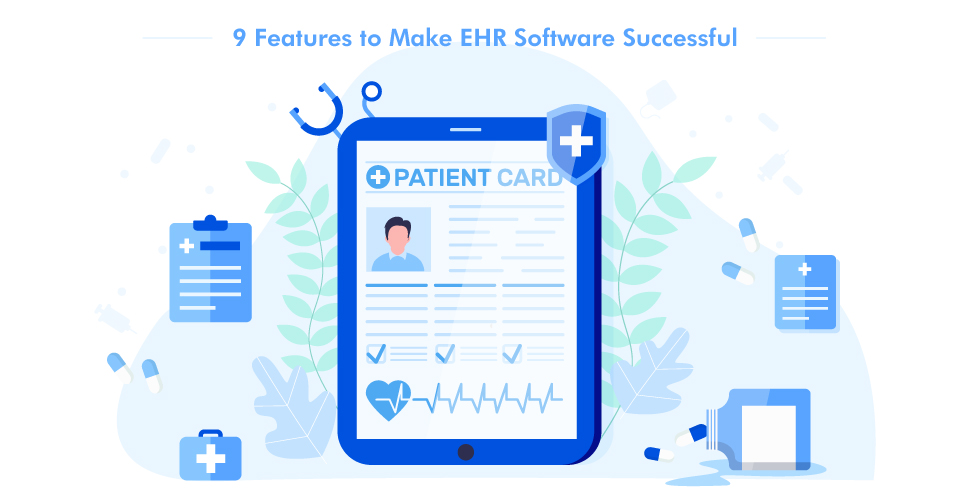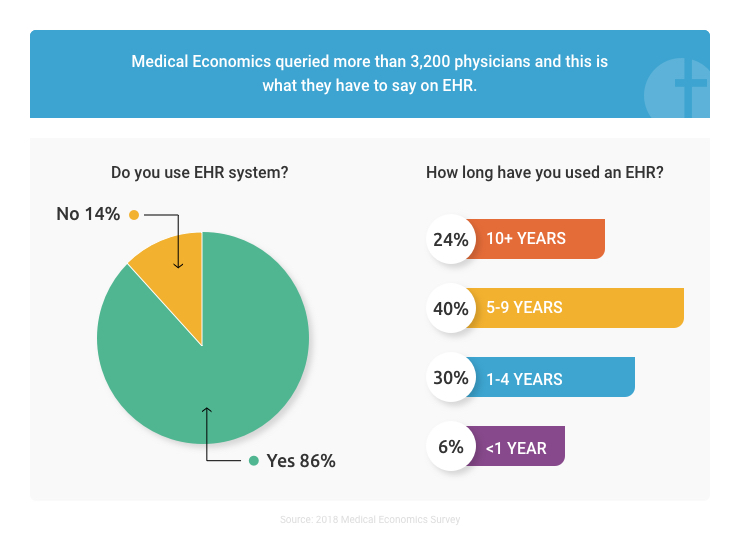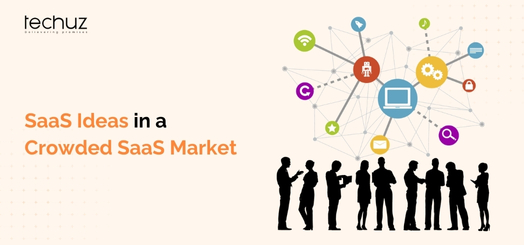Posted on
July 9, 2019
Updated on
March 20, 2024
Read time
 10 mins read
10 mins read
We live in a data-driven world. Whether it be for the profession, business or amusement — we rely on statistics and data to make crucial decisions.
No doubt, data makes the world go round — and the healthcare industry is no exception.
Doctors, nurses and other practitioners bank on patients’ health data to provide better care and improve health. If this data is channeled effectively across different practitioners, it can massively help them to enhance treatment by diagnosing the diseases, treat them, find the cause, prevent them in future and improve patients’ overall health.
This makes it indispensable to have a system that can effectively collect patient’s data, store it securely and provide ease of management as well as interoperability.
That’s when Electronic Health Records or EHR comes in.
In this article, we’ll understand — what is EHR, its benefits for doctors, practitioners, patients and other healthcare entities and must-have features to consider while developing your won EHR software.
What is EHR?
An EHR or electronic health record is a documentation software where patient’s data is stored digitally aimed to make it available to the authorized users and across different healthcare entities (such as doctors, nurses, laboratories, clinics and hospitals) whenever needed.
The data included in EHR must facilitate the practitioner to effectively treat the patient and even simplify the administrative and billing process. Usually, an EHR may include information such as:
- Patient’s demographic data
- Medical history
- Medications
- Allergies
- Immunization dates
- Laboratory test results
- Radiology images
- Vital signs
- Personal data (age and weight)
- Billing data
Traditionally, all these data were collected and stored in the form of papers and charts in a folder with the patient’s name on it. This traditional way of collecting and storing the patient’s data had many downsides including clunky management and ineffective interoperability. But EHR makes things easier.
As per the 2018 Medical Economy Survey, 86% of the physicians surveyed use EHR system in their practice and the average length of EHR use was around 7 years. Another report by Statista predicts that the global EHR market will reach $40 billion in 2024 which is almost double the size in 2015.
The above stats suggest EHR is getting huge. And it is because of the potential it holds and values it caters to the health industry. Here are some of the advantages of EHR for both practitioners and patients.
Benefits of EHR
Modern technologies have brought improvement quality of health treatment. And EHR is advancing in the same path. According to a survey, 88% of the practitioners found EHR to be beneficial for their practice. And 75% of the doctors report delivering better patient care with EHR.
Quick and real-time access to patient’s data – With EHR, doctors can have access to patient’s health data including medical history such as allergies, laboratory reports, medication and treatment to diagnose and provide treatment — even during an emergency when the patient is unconscious.
Helps in computer-aided diagnosis – EHR systems integrated with computer-aided diagnosis results in a better. Using the algorithms of EHR, computer-aided diagnosis can be way better.
E-prescriptions – Practitioners can provide e-prescriptions to the patients that can be saved for future references by both doctors and patients. It also reduces the chances of error by ineligible handwriting.
Updates and reminders – EHR provide timely reminders to practitioners for checking reports or recall the patient for checkups. While even patients get reminders about the schedule to visit the doctors.
Improves coordination – It also facilitates easy and effective communication between doctors and patients and also better coordination between different practitioners.
Better management and productive – EHR provides better management by eliminating the use of papers for patients’ medical history. On the other hand, it also automates many manual and repetitive tasks such as scheduling, reminders, notes and charting that allows the practitioners to see more patients.
Essential Features of an EHR Solution
1. Privacy and Security
Essentially the key feature that you must consider while developing an EHR Application is its security. The app stores and transmits the patient’s confidential health information known as PHI (protected health information) that must be safeguarded at all cost. And to do that EHR applications must adhere to the guidelines mentioned in the Health Insurance Portability and Accountability Act (HIPAA).
HIPAA states down a long summary of rules and regulation for varied entities but the technical requirements are mentioned in paragraph 164.312 of the document. Any health application that gets covered in HIPAA healthcare entity must follow the best practices mentioned in the law. Here are some of the tips to make your app HIPAA compliant:
- Clearly define the security requirements for the application and the architecture. A qualified security specialist must be considered for HIPAA.
- Ensure the security of the PHI by transmitting it over HTTPS network. HTTPS is a secure communication protocol that encrypts the data into meaningless characters with SSL/TLS.
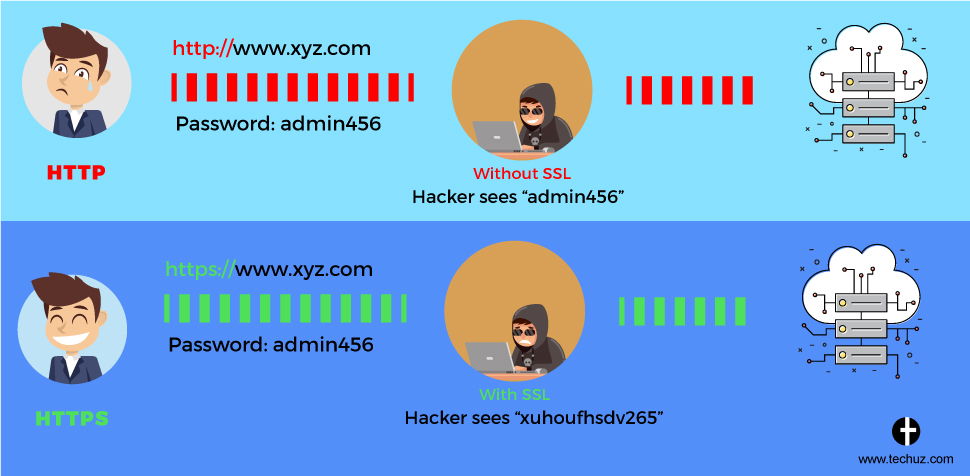
- Minimize the risk of exposing PHI data by:
- Avoiding useless access, displaying or storing of PHI data
- Don’t cache PHI whenever possible
- If the software is cloud-based make sure the cloud storage is also HIPAA compliant
- Sign a Business Associate Agreement with any third party provides.
- Implement session time-out after a certain period of inactivity.
- Don’t use PHI in the push notification.
- Follow best practices for mobile and web development such as OWASP Mobile Top 10.
2. 24/7 Access from Anywhere
The EHR solution must be accessible to users anytime and anywhere. That makes it inevitable to ensure your EHR is compatible across different browsers, operating systems and devices.
Most of the productivity software like EHR are web-based applications. This means while developing EHR, ensure that the solution supports the popular browsers — from Chrome and Safari to Internet Explorer. Further, the user experience must not be limited to certain devices. Make sure that the EHR adapts to the screen size of the device, whether it be a PC, tablet or mobile.
3. Effective Charting
A survey by Deloitte reveals the majority of the physicians considers the document related work as their least favorite and suggested that it can be done more efficiently. That’s why an EHR solution must provide a hassle-free and efficient way of documentation and charting.
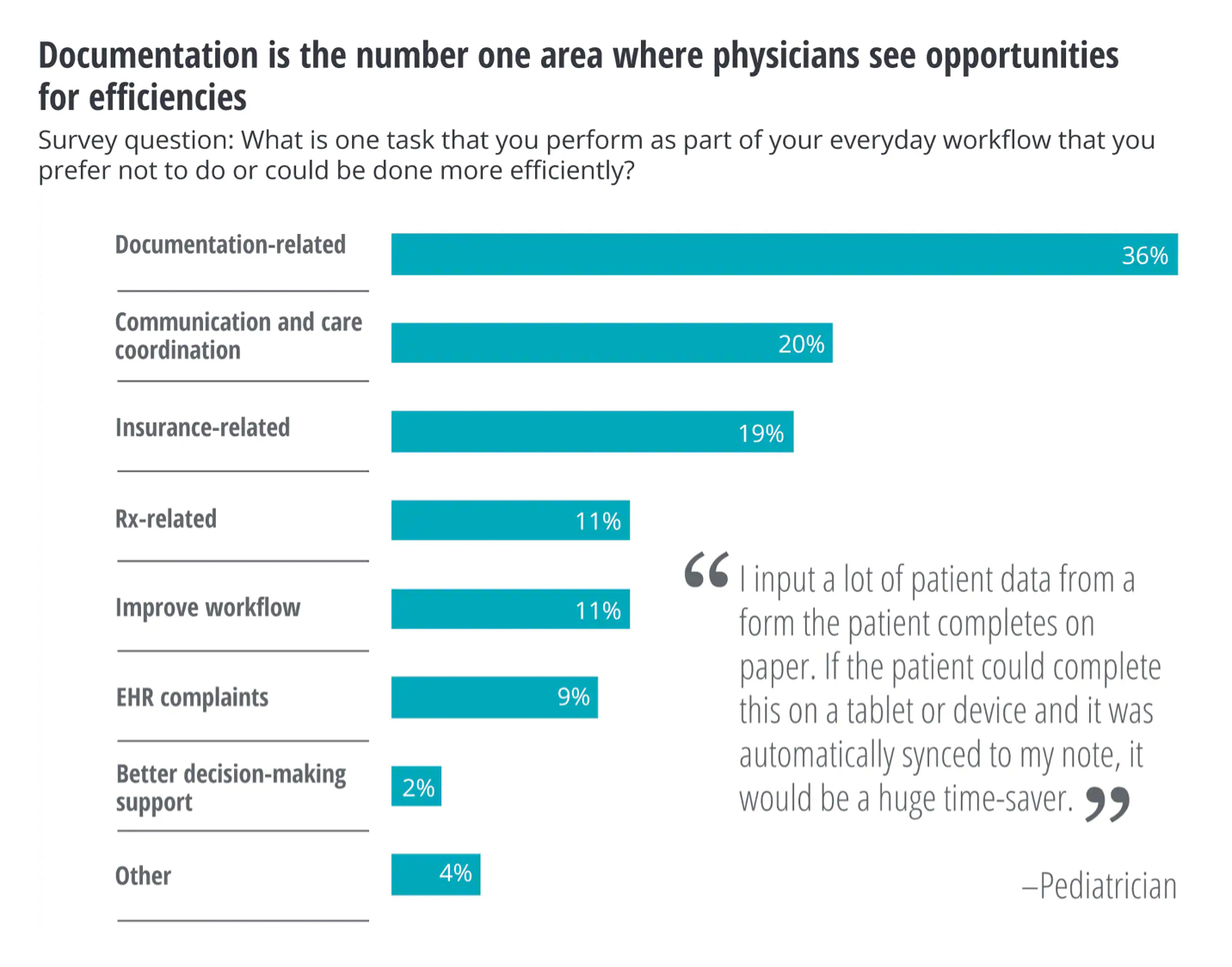
Physician Edwin Leap in his article explains that EHR solutions without efficient charting may lead practitioners to burnout. He says:
“Doctors stay after their shifts, or chart from home, or come in on their days off in order to complete their documentation. Needless to say, this is unlikely to create the best possible chart. Not only is this true, I have watched as nurses sat for one to two hours after their busy ED shifts, catching up on the ever increasing documentation requirements in their EMR systems.”
Leap also suggests that adding voice recognition for charting can make it more effective as dictating saves more time than adding the information manually. Further, efficient charting can also be aided with customizable templates as per the needs. Such customizable templates eliminate useless fields and only provide the required ones.
Another thing that you can implement in your EMR to make charting more effective is AI and machine learning. AI makes the applications smarter as it learns from the user behavior and data provided and adapts to it. Similarly, AI can be employed in EMR to learn about the previous medical records and help with suggestions for auto-filling and prompts.
4. Billing Integration
A good EMR facilitates hassle-free and fast billing system — for both practitioners and patients. It reduces the manual and time-consuming data entry, lessens any typing error and even facilities one centralized system by eliminating the need for other billing software. Even transparency can be maintained for both patient — as they can access the billing history — as well as practitioners as they can check the number of patients, claims paid and unpaid claims all at one place.
5. Patient Portal
EHR must not only provide utility to doctors and clinics but also to patients. That’s why a dedicated patient portal with some sophisticated features is necessary.
A patient portal allows the patients to log in and access their health information and take necessary actions. A patient portal usually includes:
- Access to prescriptions
- Lab tests with results
- Reports (Eg. Hospital discharge report)
- Insurance information
- History of visits
- Billing and payment information
- Allows appointment booking for convenient doctor’s appointments
- Built-in messenger to chat with doctors and necessary healthcare entities
- Download fill-out forms
6. Lab Integration
The gravity of laboratory reports is quite substantial as diagnosing the disease and treatment depends on it. Integration of EHR with labs makes the process quicker. The doctors and practitioners can review the lab tests directly from the EHR software and take steps to treat the patients.
Lab integration feature offers interoperability with other software facilitating to send and receive the reports electronically for a faster decision.
7. Clinical Templates
Apart from treating the patients, doctors have to create notes for each individual. Sometimes they treat patients with the same conditions and have to make the same notes over and over again. A good EHR system should allow doctors and practitioners to create templates that can be reused while seeing patients with similar conditions. This can save a lot of time by reducing repetitive work and allows doctors to focus on seeing more patients.
8. E-Prescription
E-prescription is the technology that allows doctors to write and send prescriptions electronically to patients or pharmacy instead of handwritten notes. Implementing e-prescription feature in EHR has several benefits such as a reduction in errors, saved record of prescribed medicines and even timely reminders for a refill. As per the Department of Health and Human Services, e-prescriptions reduce errors as they are more legible than handwritten notes which sometimes are misinterpreted while reading.
9. Simple User Interface
A simple and intuitive user interface is not only a need but must-have when the doctors will spend most of their time on the software. The design should be simple and easy on the eyes that allows them to check the information at a glance, provides intuitive workflow and quick retrieval of information. There are some principles laid down for designing an effective EHR user interface that takes care of: cognition, functionality, interaction, navigation and display must be considered while designing.
Wrapping Up
To conclude, EHR is the healthcare industry’s transition to the digital world in managing the patients’ data and treat them better. It did the same thing to the health industry that net banking has done to the banks and e-commerce has done to the retail — digitized the process for faster and effective service.
However, developing custom EHR is more complex and demanding than developing any other application. After all, a solution documenting patient’s data to help them treat better needs a high level of sophistication with enhanced security, features and expertise. This is where Techuz can help you. We are a team of professional web and mobile app developers with experience in developing EHR solutions. Our EHR software have helped practitioners, doctors, clinics and hospitals to improve productivity, better management and increase revenue. If you are looking to develop an EHR software with some sophisticated features, feel free to contact us.
